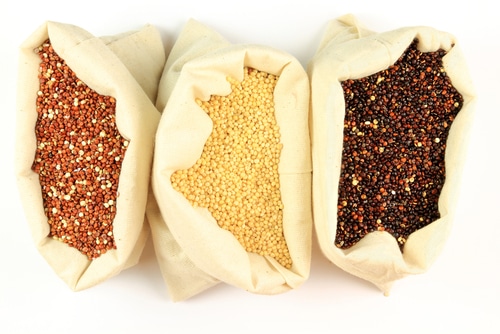
Supergrains: Chia
Chia has overcome its “chia pet” image to become one of the hottest grains on supermarket shelves. Chia seeds are an excellent source of fiber with a serving having an impressive 11 grams of heart-healthy fiber. It’s also a rich source of plant-based omega-3 fatty acids, although only a portion is converted to the more beneficial short-chain fatty acids, EPA and DHA.
You can buy chia seeds at most natural food markets and use them to make a gluten-free breakfast cereal that’ll satiate your appetite until lunchtime, thanks to its high fiber content. If you’re watching your carbs, chia seed is a good choice since it only has about one gram of net carbs per serving after you subtract out the fiber. It’s also an excellent source of bone-building calcium.
To enjoy the benefits of chia for breakfast, mix 2 or 3 tablespoons of chia seeds with warm milk or water. Let it sit for 5 minutes. Add the sweetener of your choice and fresh fruit for a fast breakfast cereal. You can also add chia seeds to smoothies, muffin recipes, yogurt, soup or salad dressings for more fiber. This is a grain you can enjoy if you’re avoiding gluten.
Supergrains: Farro
It’s one of the oldest grains in existence – and one that’s growing in popularity. With its nutty flavor and chewy texture, it makes a tasty breakfast cereal that’s high in fiber, vitamins A, B, C, E, magnesium, and iron. More chefs are embracing this super grain and adding it to recipes because of its taste, texture and health benefits. It’s a good substitute for rice and pasta in dishes, and you can add it to soups and salads to make them more filling and a better source of fiber.
Farro is popular in Northern Italy where it’s grown. It comes from a wheat-like plant, so it isn’t a good option if you’re trying to avoid gluten. Otherwise, it’s a more nutritious, high-fiber substitute for rice and pasta. It’s a complex carbohydrate that’s slowly absorbed and has almost twice the amount of fiber as brown rice.
Supergrains: Amaranth
Amaranth is a gluten-free “pseudo-grain” enjoyed by the ancient Aztecs. Unlike most grain products, it contains the amino acid lysine, which many whole grains lack and has 26 grams of muscle-building protein per cup. It’s also an excellent source of folate, vitamin B6 and most minerals and has the highest fiber content of any gluten-free grain with an impressive 13 grams per cup. You can serve it as a hot breakfast cereal and even pop the seeds like popcorn to enjoy as a high-fiber snack. Amaranth flour is an ideal choice for making bread and muffins if you’re eating a gluten-free diet.
Supergrains: Quinoa
Quinoa is a gluten-free grain that’s a complete source of protein. This versatile “super grain” that’s actually a seed is high in protein and a rich source of folate, magnesium, and iron. It’s also a rich source of antioxidant flavonoids that keep inflammation in check. Quinoa is a good choice for a high-protein, gluten-free cereal. Cook it in a slow cooker overnight the same way you would oatmeal. When you wake up, serve it with fruit and nuts and the natural sweetener of your choice. With its slightly nutty flavor, it’s a good substitute for rice.
The Bottom Line?
If you’re trying to add more fiber to your diet and are looking for a substitute for pasta and rice, try these nutrient-rich super grains. They’re also a good break from oatmeal for breakfast.
References:
World’s Healthiest Foods website.
Food Chemistry, March 2010; 119 (2): 770-778.
Whole Grains Council.
Food Navigator-USA.com. “Supergrains! Why Quinoa, Farro, Chia, and Amaranth Should Be in Every Formulator’s Toolkit”

